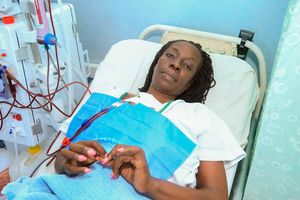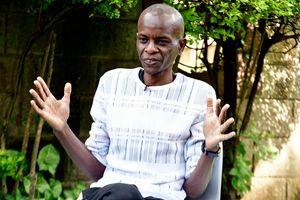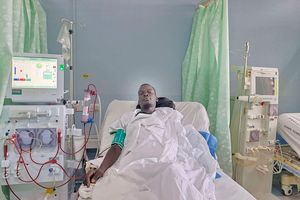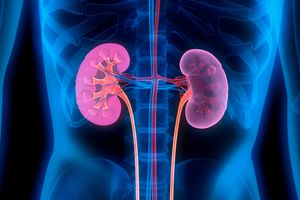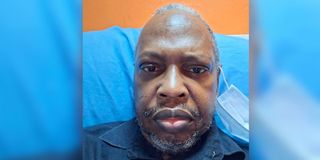
Mugambi Kiai, Article 19 Regional Director for Eastern Africa.
What prominent human rights and good governance advocate Mugambi Kiai thought was a routine medical check led to the shock discovery of a life-changing disease that has thrown him into unchartered waters. He opens up on his experience so far
On February 23, 2023, I went for a routine check-up and review of my diabetes, a condition that I had suffered from since 2007 when I collapsed in my apartment and had to be rushed to hospital. At the time, the attending doctor estimated that I had had only an hour more to survive, and another one gravely informed me that my blood had attained the dubious consistency of “uchuru” (porridge), thus severely hampering its ability to transmit oxygen throughout my body.
Back to 2023, I was being attended to in the triage section of the diabetic clinic when my blood pressure readings caused evident concern on the face of the attendant nurse. She swiftly swivelled her head look at me, for I was seated to her side.
“How did you get here?” she inquired curtly
“I drove here,” was my short reply.
By now her alarm had got to me, and I began to develop butterflies in my tummy. She then instructed me to go lie on the bed in one of the nearby waiting rooms. I complied with meek obedience.
No sooner had I settled in the waiting room than three matrons strode in. “How did you get here?” the first one asked. I repeated my earlier response to the same question that I had driven myself to hospital. “You shouldn’t even have been driving,” the second one chimed in matter-of-factly. By now the alarms bells were ringing as loudly as a foghorn in my ears, and the lights were blinking bright red in alarm. I was instantly put on some intravenous drip.
A doctor soon arrived and carried another check of my vitals, which only further confirmed what we already knew. I was quickly referred to the emergency section of the hospital. Here, as soon as I was wheeled in, blood samples were drawn for testing. Meanwhile, I was returned to the drip. When the lab results came back, the creatinine levels were found to be about 6 times the normal levels. Creatinine is a waste product of normal muscle metabolism, filtered from the blood by the kidneys and excreted in urine, and creatinine tests are used to assess kidney function, according to google.
I was swiftly transferred to another hospital where I was immediately admitted to the High Dependency Unit (HDU) for the night. I was later transferred to the ordinary ward. When it was established that, indeed, my kidneys had failed, I was put on medication and a catheter inserted in my chest to begin dialysis. This is a blood cleansing procedure where the blood with toxins is run through a machine. The challenge here is that the dialysis machine does not discriminate between the toxins and minerals present in the blood, it simply expunges all of them irrespective.
And so I began my dialysis journey, where I was expected to attend sessions at least twice a week, each for four hours. The expenses are prohibitive, although the National Hospital Insurance Fund (NHIF) and, subsequently the Social Health Insurance Fund (SHIF) covered a significant portion of the exorbitant prices involved. But it is still expensive for ordinary Kenyans. While NHIF were paying about Sh9,500 for each session of dialysis, at most twice a week, there real cost per dialysis session is about Sh20,000 per session, accounting for the medications that went hand in hand with each session. Of course, any additional costs were supposed to be covered out of pocket.
Two incidents stood out with regard to the expensive costs. In the first one, delay and non-payment by NHIF to the clinic where I was attending the dialysis sessions to another one that was still taking the Fund’s payments. This led to a situation where I gained weight while still wasted in muscle fibre. It was explained that this was why my legs had also begun to progressively swell. As my nephrologist explained, “This guy is full of water!”
Because the dialysis machine is indiscriminate with what it cleans from the blood, the tendency to lose energy, appetite and feel lethargic and physically weak is ever present. My muscles wasted and I began to walk in a shuffle, painfully dragging my feet from one point to the next. Then came the postural hypotension, where blood pressure suddenly drops when you stand and you collapse in a heap to the floor. I had three such episodes, happily, in none of them did I suffer grievous injuries, only suffering soft tissue injuries and an enormously bruise to my ego.
My ego took another beating when I was required to take a heart function test. Among the requirements for this test, one is asked to get onto a treadmill and run up an imaginary hill, with the treadmill mimicking a progressively rising slope for 10 minute.
“I can do this,” I psyched myself with cautious optimism, “After all, I was not a utility rugby player at club level for nothing.”
Shock on me! I didn’t even last a full minute climbing that imaginary hill. Oh, the humiliation! Oh the indignity! The sheer opprobrium!
This failed test led to a CT angiogram, a medical imaging technique, to check if my heart had any issues in terms of the tissues and blood circulation. A lung functioning test was subsequently carried out. This led to another cavernous alley. The biopsy had unearthed a mass in the bottom left lobe of my lungs. My horrified response to this sobering news was, “Could it be malignant? Cancerous, even?” It turned out to be benign, thank God!
Other intrusive tests followed, like the colonoscopy where they run a tube up the rectum to establish that the alimentary system works well. And the Micturating Cysto-Urethrogram (MCU) test that inserts a catheter up your urethra to test the state of the gall bladder.
I then started considering a kidney transplant option. There were two scheduled meetings, one of the Ethics Committee where both the donor and I met a team of doctors from the hospital to establish our suitability for the transplant. It was here that my nephrologist peremptorily instructed, “You must shave your dreadlocks,” because they would hinder effective post-transplant care. At the Multi-Disciplinary Team (MDT) meeting, we had a conversation with the doctors who would be carrying out the transplant.
By far one of the most difficult challenges was identifying a volunteer to be my kidney donor, which was managed only after three tries, with each potential kidney donor dropping out for one reason or another. It was the fourth volunteer, my angelic cousin, who kindly volunteered to be my kidney donor.
And so we went for the transplant on March 12, 2025. It was successful and I was discharged within seven days of admission. I had to be readmitted, however, when they discovered a urinary infection and also, more morbidly, that my immune system had become more aggressive towards the grafted kidney. To counter these, I was placed under some antibiotics and also required the Double Filtration Plasma Pherosis (DFPP) treatment or plasma cleansing. Here, plasma is separated from the rest of the blood and antibodies are harvested. This degrades their ability to attack the grafted kidney. Because of this, I am now even more susceptible to the risk of opportunistic infections. Hence, I remain in isolation and will continue to be isolated for the foreseeable future.
But I can still think, analyse and write, so, let me reintroduce myself. My name is Mugambi Kiai, a staunch advocate for democracy, good governance, the rule of law, and human rights. I now am the proud owner of three kidneys, two non-functional and one functional. Of course you know that they don’t remove the non-functional kidneys when they graft the transplanted one in the body, don’t you? What you do with this information is up to you.
Mugambi Kiai is the Regional Director, Eastern Africa at Article 19, a freedom of expression watchdog.

